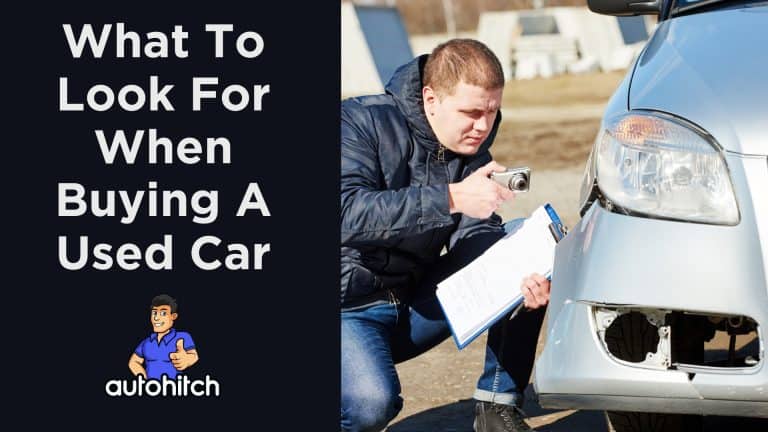Whether scanning listings or visiting dealership lots, it’s essential that you know exactly what to look for when buying a used car in order to save money and avoid buying a lemon.
Based on my time owning and operating a dealership in Florida, I created the checklist below that covers what features to look for in a used car, the questions to ask, documents to review, and tests to conduct when shopping for pre-owned transportation.
Related Articles To Read:
- How Many Miles Should A Used Car Have
- The Top 21 Questions to Ask When Buying a Used Car
- How To Negotiate Used Car Price
- How Much Do Dealers Markup Used Cars
- How Much Will Dealers Come Down on a Used Car?
- Is It Suspicious to Buy a Car With Cash
Table of Contents
1. Do Your Research on Pricing and Model Types
Before visiting any dealers or private sellers, create a target list of makes and models that fit your budget and needs.
Resources like Kelley Blue Book and Consumer Reports offer reliability ratings, typical issues, and pricing guidance to narrow your choices. This information also aids negotiations later.
Set a firm maximum budget based on used car value guides, and get pre-approved financing if needed. This further assists in finding an affordable option and negotiating from a position of strength.
2. Check the Vehicle History Report For Accident History
Always examine the free CARFAX or AutoCheck vehicle history report from the seller. Key details include:
- Number of previous owners
- Odometer readings confirming mileage
- State safety and emissions inspection records
- Title information indicating salvage or rebuilt status
- Accident and damage reports
- Flood exposure
- Service and maintenance history
While helpful, these reports may have inaccuracies or omissions. Hence, additional research is required.
Helpful Article: Carfax Vs. AutoCheck
3. Ask About the Mechanical History and Repairs
Inquire if maintenance records are available. Request receipts showing routine servicing and major repairs at the vehicle owner’s manual intervals.
Frequent oil changes suggest attentive care.
Also ask whether any components need repair now, and factor those costs into purchase negotiations. A pre-purchase inspection (see Step 8) can reveal other issues.
4. Ownership History
Learn how long the seller possessed the car and their usage. Long-term ownership indicates familiarity with the vehicle. Also clarify why they are selling and if private sellers have the title in hand.
Dealers should provide title conveying legal ownership. Be wary of any title branding as salvage or rebuilt, which indicates past extensive damage.
5. Safety features
Look for modern safety features like airbags, anti-lock brakes, stability/traction control, rearview cameras, blind spot monitoring, etc. These can vary widely between older and newer models.
6. Examine the Exterior Condition
Conduct a thorough walkaround, checking all panels and paint for inconsistencies indicating accident repairs. Are there large scratches, scrapes, or dents? What about bubbles or chips suggesting rust below the surface?
Inspect tires for abnormal or uneven wear. Look for complete spare, jack, and tools as well. Consider when tires will need replacement.
Open and close doors, hood and trunk to check condition and proper alignment. Test all lights plus windshield wipers and fluid spray.
7. Review Fluid Levels and Leaks
Check underneath for wet spots indicating leaks. Also inspect the engine oil, coolant/antifreeze, brake fluid, transmission fluid, and power steering fluid levels yourself or take to a mechanic. Fluids should appear clean and at proper heights, not murky or foamy.
Replenish any low fluids before buying, and get quotes on repairs for serious leaks if concerned.
8. Assess the Interior Thoroughly
Look for ripped upholstery, faded plastic or carpets with mold, mildew or cigarette smells. Turn on fans, heat, AC and all technology features. Do air vents, lights, gauges, screens, stereos, Bluetooth and chargers function correctly? Move the seats to confirm adjustment motors work on both sides.
9. Verify Recent Emissions and Safety Checks
Ask the seller to share latest test records, which may detail any failed points to address. If unavailable, schedule your own emissions and safety inspections to uncover deficiencies after purchase negotiations. This also protects against buying an illegally unsafe vehicle.
10. Get a Pre-Purchase Inspection (PPI)
Pay ~$100-$200 for an independent mechanic’s pre-purchase inspection before finalizing a deal. A mechanic will lift the vehicle on a rack and diagnose the engine, drivetrain, electronics, tires and chassis for issues.
Ask for a written PPI report detailing any advisable near or longer term repairs. Use this to request service coverage, deduct repair costs from the offer, or potentially walk away.
11. Review Predicted Ownership Costs
Use online calculators to input make, model, year and mileage to estimate annual costs for insurance, fuel, tires, maintenance and repairs. Ensure total ownership budgets fit within your financial means.
Insurers also offer quotes based on your specifics. Review these to incorporate with ownership cost estimates before committing to buy.
12. Check Warranty Coverage
Clarify any remaining original or certified pre-owned (CPO) warranty duration on vehicles advertised as such. Review covered components, commercials vs. powertrain, deductibles, and warranty provider (manufacturer vs. third party).
Consider purchasing an extended warranty on your own for expensive luxury or sport models past original coverage. Otherwise inspect PPI report thoroughly when lacking this safety net.
13. Verify Clean Title Again At Sale
After checking research and inspections, reconfirm the title is in the seller’s name when signing transfer paperwork. Pay only once the title proving ownership is available.
Review the title to verify it matches the VIN and model details. Finally, leave with the title properly signed over to your name to complete the purchase.
Related Article: How To Sign Over A Car Title
Take a Lengthy Test Drive
A 20-30 minute test drive reveals noises, vibrations or mechanical problems. Listen closely and check handling around corners and on rough roads.
Does the transmission shift smoothly? Do brakes feel responsive? Are steering and pedals tight or loose? Make notes on any concerns to research or address later.
Key Takeaways
- Research reliability and pricing on models of interest before shopping
- Examine free vehicle history reports for ownership, repairs, accidents
- Take a lengthy test drive, checking for issues
- Assess exterior interior condition; fluid levels, tire wear
- Get a pre-purchase inspection revealing problems
- Calculate ownership costs with insurance, fuel, and repair estimates
- Verify remaining warranties on certified pre-owned cars
- Recheck for clean title at sale before signing
Sources For this Article:
- https://roboticsandautomationnews.com/2022/04/05/the-most-typical-flaws-in-used-cars/50124/
- https://www.nyc.gov/assets/dca/downloads/pdf/businesses/DCAInspectionChecklist_SecondhandAutoDealer.pdf
- https://carro.sg/blog/the-three-most-common-problems-in-used-cars/
- https://cars.usnews.com/cars-trucks/advice/how-to-buy-a-used-car
- https://consumer.gov/managing-your-money/buying-used-car



